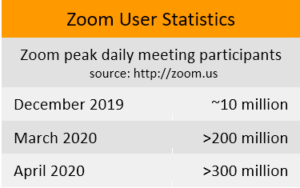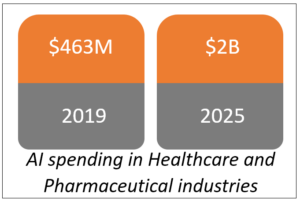Change is here!
It is not difficult to see that the world looks different during the COVID-19 pandemic. No cure, no vaccine, and the chances of catching the virus are real. The assumption that things will go back to normal afterward is inaccurate and not practical.
The pandemic is presenting us with many challenges that require us to adjust our way of living. Challenges that we observe in our social and economic lives. Social distancing is preventing us from interacting with our family, neighbors, coworkers, with many people losing their job. Restaurants are only offering take-out. Online entertainment such as Netflix, Disney+ is booming. Online retailers are benefiting from people staying at home at the expense of brick and mortar stores. We are all facing similar challenges, and this is an opportunity to work together towards a common goal with a radical approach, fueled by innovation. Artificial Intelligence (AI) is powering that innovation!
AI and the fight against the novel coronavirus
Detecting an outbreak
Many experts are debating when the virus outbreak really started. At the end of December 2019, the Canadian company BlueDot was notified by its AI platform of an epidemic in Wuhan, China, which was two weeks before the World Health Organization (WHO) acknowledged the existence of the new virus. When dealing with a pandemic, time is of the essence, and AI is a vital tool that can help detect changes earlier, make predictions, and save lives.
Getting to know the virus
There is an immediate demand from healthcare and biotech players to increase development and investment in AI, as it is one of the most promising technologies that can help decipher the SARS-CoV-2. This is a novel virus, and researchers do not fully understand it yet. AI can help by quickly pinpointing areas of interest as it continuously analyses the incoming data. Researchers augmented with AI have sped up their learning and knowledge of the virus significantly.
A team from the Kellogg School of Management developed a machine learning tool that exponentially shortens the peer review period of scientific studies, from months to minutes. Dr. Uzzi’s team trained their model to identify which studies have high reproducibility. Applying this model to the emerging COVID-19 studies will dramatically speed up the process of making a distinction between promising research and misinformation from poor-quality studies.
Joined Forces
Many healthcare organizations have joined forces and created strategic alliances. Together they form a broader front to combat COVID-19. Some are putting aside competition for the greater good, like Apple & Google. The goal is to apply AI to help detect the virus, minimize the spread through contact tracing, produce a vaccine, and eradicate SARS-CoV-2.
The combined initiatives make up the perfect ingredients for a burst of innovation and consist of sharing data, resources, compute capacity, and software.
- Data: Larger data sets allow for improved models and more meaningful results.
- Resources: Ideas and concepts are shared across the various teams to build up a broader knowledge base, which, in return, provides more research avenues to pursue.
- Compute:
- Public clouds such as Amazon Web Services (AWS), Google Cloud Platform (GCP), and Microsoft Azure are providing critical compute power to COVID-19 projects to process the data and expedite the results.
- Vendors are working together to bring solutions to the market so that researchers can focus on doing research instead of spending time setting up infrastructure.
- Software: New and improved AI methodologies and techniques are co-developed to accommodate the needs of the COVID-19 projects.
The AI advances will not be limited to healthcare, biotech, and pharma. AI is all about data, and similar applications will significantly benefit from the new and improved methodologies.
Remote work

With social distancing in place, many employees had to resort to working from home. To be productive and stay in contact with coworkers, employers looked at enterprise office applications to fill the gap. The demand for applications such as online video conferencing is another growth area for AI. To put the growth in perspective, Zoom, a company that provides online video conferencing, had 10 million daily meeting participants before the outbreak of COVID-19 (December 2019) and over 300 million by late April 2020. Zoom relies on AI to recognize user patterns, to identify issues during calls and areas for improvement. Zoom isn’t the only player in the market but gained enough attention lately that Facebook released their version called Facebook Messenger Rooms and is available for free. Facebook is well known for understanding the value of data and using AI to generate revenue.
It is important to note that working remotely will not go away. It is here to stay and will become part of our routine. The goal is to work remotely from ‘anywhere’, not just from home.
Social distancing
Companies are figuring out how to reopen the workplace and what policies to put in place. Social distancing is essential to prevent the spread of the virus. Computer vision tools, powered by AI, will be utilized to help enforce these policies.
Investing in AI
Companies will accelerate their digital transformation plans to increase productivity. AI will be at the forefront. Automation, supply chain, facial recognition, authentication, robotics, and transportation are just a handful of markets that will significantly improve their productivity with the use of AI and machine learning. As AI deployments grow and more data is collected and analyzed, productivity will spike.
AI did not need COVID-19 to point at its importance and how it extracts useful information and insights from data. But COVID-19 will dictate the direction and drive the innovation for AI with a long-lasting impact.
It is too early to know the exact investment impact across the markets. Initially, not all AI markets will benefit equally as priorities will shift. Some markets might see reduced investments, while others like healthcare, pharma, and biotech will see a significant injection of capital. Time and financial market analysts will provide evidence on the size and shape of these investments.

According to a recent press release by ABI Research, the pandemic has proven that healthcare institutions can no longer ignore the role of AI. AI spending in the healthcare and pharmaceutical industries is expected to increase from $463 million in 2019 to more than $2 billion per year over the next five years.
I believe the combination of new investments combined with the need for faster insight and information, not just bigger data sets, will increase the overall demand for Artificial Intelligence. AI has always been about adaptation: the concept of improving the AI model with new data is a fundamental principle. Organizations that are already employing AI can adapt fast, embrace change, and take advantage of the opportunities as they present themselves. Others find themselves in unfamiliar territory, forced to think outside the box, and the need to get results fast.
Conclusion
The pandemic is forcing a rebalance in investments across all IT investments, especially the AI markets. The healthcare and biotech markets are experiencing a steep increase in investments with a fast-growing adoption of AI. Many organizations have joined forces to accelerate the development of a treatment for COVID-19. The practice of social distancing is also expediting the AI efforts around working remotely. These are just a few examples of areas where AI can help make a difference defining the new normal.
The innovation of AI in existing markets and the incorporation of AI in new markets will benefit the greater AI community. In times like this, people come together and drive creativity and innovation.
